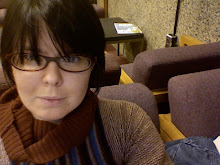First of all, a LOST AND FOUND message. I don't know if you're reading this, but Alice I've lost your address in Maryland, and I've written you a postcard I want to send! So, if you happen across this, please send me your address! I haven't forgotten my promise.
Now that my scatterbrained nature is dealt with, I can move on.
My last day in Montreal, and it will be a quiet one. Over the past few days I've become well-acquainted with the man at the postoffice, and I have to visit him one more time to mail one last thing home. I feel like I've jettisoned much that I've acquired over the last month, so I'm almost beginning again - except my scrapbook is bulging. Other than a visit to the post office (and the weather is beautiful today - sunny and mild after the weekend snow) I'm just going to be milling around, packing, knitting, reading. A gentle day before I traipse off to London. (And yes, is the answer to my mother's question. I AM going to London to visit the Queen.)
Yesterday I went to the Museum of Fine Arts. They have a major exhibition on, but I decided instead of seeing that I'd make my way around the permanent collection. I'm very glad I did this - spent a lot of time looking at the pre-Columbian, Asian, Oceanic and African art, and making little notes on things. I was especially taken with an African idiophone - the "Disaster Bird" idiophone. One day a bird warned the Obo (king) against a battle. The king ignored his advice, and won the battle. Since this time, the Obo has been considered the person who can determine fate, and there is an annual celebration of this victory.
I also spent quite a long time among the contemporary art. A beautiful Hans Hoffman - I've begun to realise that I love Hoffman's work: the same extremely bold juxtapositions of colour as there are in the work of Howard Hodgkin, another of my favourite painters. Against the scale of many Abstract Expressionist canvases, Hoffman's works are quite small (though large enough that they would dominate an ordinary room without hesitation) - but they're colour seems much more demanding than the colour of a Pollock, or a Rothko, or a Newman... His use of complimentary colours - in this case a canvas dominated by luminous, orangey red, with attacks of a bright green. Something both violent, but also joyful in this onslaught of colour. A very thick texture to the paint, not the drip texture of a Pollock, but most probably the thick application of the palette knife.
There were two rooms dedicated to the two major Canadian artists - whose works I also saw at the Contemporary Art Museum - Riopelle and Borduas. I think after seeing 30 or 40 of each of their works I can tell their styles quite well now. I admire Riopelle - think his "mosaic" period of abstraction particularly interesting - but don't find the works as engaging as the work of Borduas. Borduas moved slowly away from figurative painting, into his "automatiste" style, comparable to the practice of automatic writing, and not dissimilar to the aims of American abstract expressionism. The landscape is still obvious as the subject of his middle-period abstraction, but toward the end of his life he began to abandon colour, and these last canvases are dominated by white: somehow giving the viewer a feeling of both despair and a strange kind of warmth in their solitary vision. There are still occasional bold slashes of colour - "Composition 59" is dominated by a wide, vertical olive green streak across it - but for the most part he is heading toward monochrome. One of his late Compositions is wholly white, all texture. There seems some kind of striving towards a pure vision in the passage of these paintings.
The other interesting thing I found was that the gallery had on display two pieces on 1986 by Gerhard Richter - one of his photographic paintings, and one of his abstractions. They displayed these pieces in two different galleries. I love that split in Richter's oeuvre.
Montreal
An Australian poet in Washington, DC
Kate, Underground.

Kate Middleton is an Australian poet currently living in the US, studying hard and writing here when she has time. This is a space both to keep in touch, and to keep up with the world of poetry, poetics and other writerly encounters.
I can be contacted at katemid [at] gmail [dot] com
|
|
| Subscribe to misskateunderground |
| Visit this group |
Adventures Underground

About Me
Other tidbits
- A Tonalist Notes (Laura Moriarty)
- Adam Aitken
- Bill Emory
- Bits and Ends
- Davey Dreamnation (David Prater)
- Dumbfoundry
- I like the noise
- Ilya Kaminsky
- Independence Day Project
- Ivy is Here (Ivy Alvarez)
- Karolinka In & Around Bulgaria
- Kate Fagan
- Lulu Illustrated
- Matilda
- Matthew Thorburn
- Nomadics (Pierre Joris)
- Reading Your Favourites
- Ruby Street (Jill Jones)
- Silliman's Blog
- Szia Robyn!
- The Little Prophet
- The Little Workshop (Cassie Lewis)
- Theatre Notes (Alison Croggon)
Further Adventures Underground

My poems on the web
I like to read
Interesting organisations
Continued Adventures Underground

Presses
Labels
- actresses (1)
- australia (2)
- books (8)
- concerts (1)
- events (8)
- exhibitions (6)
- films (4)
- Fire Season (1)
- friends (1)
- independence day project notes (11)
- news (1)
- notebook (13)
- papers (2)
- people (4)
- performances (6)
- poetry (13)
- readings (17)
- reviews (2)
- sightseeing (1)
- status report (21)
- study (24)
- teaching (14)
- travel (13)
